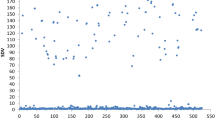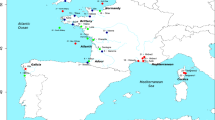Abstract
We estimated the amount of genetic divergence between two morphologically similar species of southern African hake, Merluccius capensis and M. paradoxus, with the electrophoretic analysis of proteins encoded by 31 loci. Nei's genetic distance between these taxa was 0·583 (±0·160) and is typical of evolutionary divergence between well differentiated congeneric species. We found no evidence of hybrid individuals. The mean heterozygosity over 13 samples of M. capensis was 0·055 and over 10 samples of M. paradoxus was 0·067. The present sympatric distributions of these fish are most likely the result of secondary contact after speciation in allopatry or the result of repeated dispersals of ancestral populations of other Atlantic Ocean hakes to southern Africa, rather than the result of sympatric speciation. There were significant excesses of rare alleles in both species as compared with that expected for neutral alleles in species at drift-mutation equilibrium. Average heterozygosities, however, were not appreciably reduced in comparison with other marine fish. Using genetic distance and the assumptions of the molecular clock, we estimate that the lineages leading to these species diverged from one another between 7 and 13 million years ago.
Similar content being viewed by others
Article PDF
References
Archie, J W. 1985. Statistical analysis of heterozygosity data: independent sample comparisons. Evolution, 39, 623–637.
Becker, I I, Grant, W S, Kirby, R, and Robb, F T. 1988. Evolutionary divergence between sympatric species of southern African Hakes, Merluccius capensis and M. paradoxus. II. Restriction enzyme analysis of mitochondrial DNA. Heredity, 61, 21–30.
Bentz, K L M. 1976. Gillarch morphology of the Cape hakes, Merluccius capensisCast, and M. paradoxus Franca. Fish Bull S Afr, 8, 17–22.
Botha, L. 1980. The biology of the Cape Hakes Merluccius capensis Cast, and M paradoxus Franca in the Cape of Good Hope Area. Ph.D. Thesis, University of Stellenbosch, South Africa, 182pp.
Cabo, F L. 1965. Las merluzas atlanticas. Publ Dir GenPesca Marit, 4, 208.
Carlson, S S, Wilson, A C, and Maxson, R L. 1978. Do albumin clocks run on time? A reply. Science, 200, 1183–1185.
Chakraborty, R, and Nei, M. 1977. Bottleneck affects on average heterozygosity and genetic distance with the stepwise mutation model. Evolution, 31, 347–356.
Chakraborty, R, Haag, M, Ryman, N, and Stahl, G. 1982. Hierarchical gene diversity analysis and its application to brown trout population data. Hereditas, 97, 17–22.
Climap. 1976. The surface of the ice-age earth. Science (Wash., DC)191, 1131–1137.
Fitch, W M. 1976. Molecular evolutionary clocks. In Ayala, F. J. (ed.)Molecular Evolution, Sinauer Assoc. Inc., Sunderland, Massachusetts, pp. 160–178.
Ferris, S, and Whitt, G. 1978. Genetic and molecular analysis of nonrandom dimer assembly of the creatine kinase isozymes of fishes. Biochem Genet, 16, 811–829.
Franca, P. 1954. Contribuicao para o conhecimento do genero Merluccius no Atlantico oriental ao sul do equador. Trabhs Miss Biol Marit, 8, 46–98.
Franca, P. 1971. Hipoteses acerca da provavel ocorrencia de Merluccius merluccius paradoxus Franca 1960 em aguas Angolanas. Not Cent Biol Aquat Trop, 26, 1–18.
Fuerst, P A, Chakraborty, R, and Nei, M. 1977. Statistical studies on protein polymorphism in natural populations I. distribution of single locus heterozygosity. Genetics, 86, 455–483.
Futuyma, D J, and Mayer, G C. 1980. Non-allopatric speciation in animals. Syst Zool, 29, 254–271.
Inada, T. 1981. Studies on the Merlucciid fishes. Bull, Far Seas Fish Res Lab, Shimizu, Japan. 18, 1–172.
Jones, B W, and Mackie, I M. 1970. On application of electrophoretic analysis of muscle myogens to taxonomic studies in the genus Merluccius. Comp Biochem Physiol, 32, 267–273.
Kabata, Z, and Ho, J-S. 1981. The origin and dispersal of hake (genus Merluccius: Pisces: Teleostei) as indicated by its copopod parasites. Oceanogr Mar Biol Ann Rev, 19, 381–404.
Kimura, M, and Crow, J F. 1964. The number of alleles that can be maintained in a finite population. Genetics, 49, 725–738.
Kimura, M, and Ohta, T. 1971. Protein polymorphism as a phase of molecular evolution. Nature, 229, 467–469.
Markert, C L, and Eaulhaber, I. 1965. Lactate dehydrogenase isozyme patterns of fish. J Expl Zool, 159, 319–332.
Maruyama, T, and Fuerst, P A. 1984. Populations bottlenecks and nonequlibrium models in population genetics. I. Allele numbers when populations evolve from zero variability. Genetics, 108, 745–763.
May, B, Shaklee, J B, and Stoneking, M. 1979. Joint segregation of biochemical loci in Salmonidae: results from experiments with Salvelinus and review of the literature on other species. J Fish Res Bd Can, 36, 1114–1128.
Meyer-Rochow, V B. 1972. A note on some parasites of Merluccius capensis (Pices) and their zoogeographical significance. Afr J Trop Hydrobioi Fish, 2, 82–84.
Nei, M. 1972. Genetic distance between populations. Amer Natur, 106, 283–292.
Nei, M. 1973. Analysis of gene diversity in subdivided populations. Proc Natl Acad Sci USA, 70, 3321–3323.
Nei, M, and Roychoudhury, A K. 1974. Sampling variances of heterozygosity and genetic distance. Genetics, 76, 379–390.
Nei, M, Maruyama, T, and Chakraborty, R. 1975. The bottleneck effect and genetic variability in populations. Evolution, 29, 1–10.
Payne, A I L, Augustyn, C J, and Leslie, R W. 1986. Biomass index and catch of Cape hake from random stratified sampling cruises in division 1.6 during 1984. Colln Scient Pap Int Comm SE Atl Fish, 12, 99–123.
Radinsky, L. 1978. Do albumin clocks run on time? Science, 200, 1182–1183.
Ridgway, G J, Sherbourne, S W, and Lewis, R D. 1970. Polymorphism in the esterses of Atlantic herring. Trans Am Fish Soc, 99, 147–151.
Rosen, D E. 1978. Vicariant patterns and historical explanation in biogeography. Syst Zool, 27, 159–188.
Shaklee, J B, Tamaru, C S, and Waples, R W. 1982. Speciation and evolution of marine fishes studied by the electrophoretic analysis of proteins. Pac Sci, 36, 141–157.
Shannon, L V. 1985. The Benguela ecosystem. Part. I. Evolution of the Benguela physical features and processes. Oceanogr Mar Biol Ann Rev, 23, 105–182.
Shaw, C R, and Prasad, R. 1970. Starch gel electrophoresis of enzymes—a compilation of recipes. Biochem Genet, 4, 297–320.
Skibinski, D O F, and Ward, R D. 1982. Correlation between heterozygosity and evolutionary rate of proteins. Nature, 298, 490–492.
Sokal, R R, and Rohlf, R J. 1981. Biometry. 2d. ed., Freeman and Co., San Francisco CA. 859 p.
Szidat, L. 1961. VersucheinerZoogeographie des Sud-Atlantik mit Hilfe von Leitparsiten der Meeresfische. Parasitol Schr Reihe, 13, 1–98.
Thorpe, J P. 1982. The molecular clock hypothesis: biochemical evolution genetic differentiation and systematics. Ann Rev Ecol Syst, 13, 139–168.
Van Eck, T H. 1969. The South African hake: ‘Merluccius capensis’—or ‘Merluccius paradoxus’? S. Afr. Shipp. News Fish Ind Rev, 24, 95–97.
Wawter, A T, Rosenblatt, R, and Gorman, G C. 1980. Genetic divergence among fishes of the Eastern Pacific and the Caribbean: Support for the molecular clock. Evolution, 34, 705–711.
Watterson, G A. 1984. Allele frequencies after a bottleneck. Theor Pop Biol, 26, 387–407.
Whitt, G S. 1970. Developmental genetics of the lactate dehydrogenase isozymes of fish. J Expl Zool, 175, 1–35.
Winans, G. 1980. Geographic variation in the milkfish Chanos chanos. I. Biochemical evidence. Evolution, 34, 558–574.
Author information
Authors and Affiliations
Rights and permissions
About this article
Cite this article
Grant, W., Becker, I. & Leslie, R. Evolutionary divergence between sympatric species of southern African Hakes, Merluccius capensis and M. paradoxus. I. Electrophoretic analysis of proteins. Heredity 61, 13–20 (1988). https://doi.org/10.1038/hdy.1988.86
Received:
Issue date:
DOI: https://doi.org/10.1038/hdy.1988.86
This article is cited by
-
Phylogenetic prospecting for cryptic species of the genus Merluccius (Actinopterygii: Merlucciidae)
Scientific Reports (2021)
-
Genetic relationships among Merluccius species
Heredity (1999)
-
Biochemical genetics of Indian pygmy field mice: Superoxide dismutase (Sod-1) as a diagnostic marker inMus booduga
Biochemical Genetics (1996)
-
Evolutionary divergence between sympatric species of southern African Hakes, Merluccius capensis and M. paradoxus. II. restriction enzyme analysis of mitochondrial DNA
Heredity (1988)



